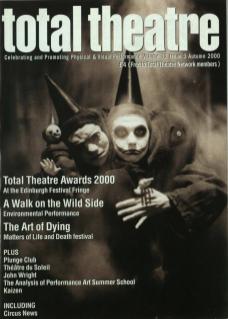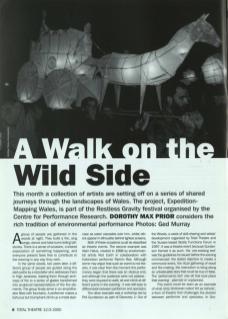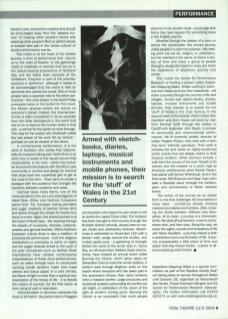A group of people are gathered in the woods at night. They build a fire, sing songs, dance and take turns telling tall stories. There is a sense of occasion, a shared expectation of something happening, and everyone present feels free to contribute to the evening in any way they wish.
In the same woods, two years later, a different group of people are guided along the dark paths by a storyteller who addresses them in High Javanese, leading them through archways of fire to a series of gates transformed into sculptural representations of the five elements. The group finally arrive in an amphitheatre filled with fountains. A performer makes a tortuous but triumphant climb up a metal staircase as water cascades over him, whilst others appear in silhouette behind lighted screens.
Both of these occasions could be described as theatre events. The second example was Alam Halus, created in 1998 by environmental artists Red Earth in collaboration with Indonesian performer Parmin Ras. Although some may argue that such an event is not theatre, it was clear from the moment this performance began that there was an obvious end, and although the audience were not passive – they were required to walk, sit and climb at different points in the evening – it was still easy to differentiate between performer and spectator. The other example was a workshop led by Phil Gunderson as part of Discovery 1: Out of the Woods, a week of skill-sharing and artists development organised by Total Theatre and the Sussex-based Bodily Functions Forum in 1997. It was a theatre event because Gunderson framed it as such. His ‘pre-existing text’ was the guidelines he issued before the evening commenced: the stated objective to create a communal event, the ritual gathering of wood and fire-making, the instruction to bring along an unbelievable story that could be true or false. The ‘performance text' was all that took place that evening – planned or unplanned.
This event could be seen as an example of what Jerzy Grotowski called ‘Art as Vehicle', a form of theatre that challenges the division between performer and spectator. In Grotowski's view, everyone is creative and should be encouraged away from the ‘passive culture' of reading other people's books and watching other people's films or performances to instead take part in the 'active culture' of shared performance events.
This notion is at the heart of the shared journey, a form of performance that returns us to the roots of theatre: to the gatherings made to celebrate or worship that live on in the statue-bearing processions of Northern Italy and the Mardi Gras carnivals of the Caribbean. Everyone is part of the process, everyone a performer – although it needs to be acknowledged that the event is held by someone who carries the crowd. One or more people have a separate role to the other participants – the cross-bearer in the Good Friday procession takes on the burden for the crowd, the African shaman enters the trance on everyone's behalf. Indeed, the shaman/performer is often considered to be so separate from the other participants in the event that she or he is beyond the human whilst in that role – a vehicle for the spirits to move through. This may be the reason why Grotowski called the last phase of his work ‘Art as Vehicle' – perhaps we are all vessels of the divine.
In contemporary performance, it is the artist or facilitator who carries that responsibility for everyone taking part. Keith Khan is an artist who is aware of the issues around that responsibility. In his work – which has included environmental projects with the Brick Lane community in London and design for Carnival that strips back the superficial glitz to get at the roots of the form – Khan aims to create a dialogue with the audience that changes the hierarchy between audience and artist.
Carnival takes many forms, one of the most prevalent is the pre-Lent extravagance of Mardi Gras. Whilst cold Northern Europeans spend their 'Fat Tuesdays' eating pancakes and sugar, residents of warmer climes drink and dance through the streets for twenty-four hours or more. Again, the shared journey is at the heart of Mardi Gras – the weaving through the streets of musicians, dancers, costume-wearers and general revellers. Within Northern European culture there is also a tradition of processional performance – both the religious celebrations or entreaties to saints or virgins and the pagan festivals linked to the cycle of the year. Companies such as Welfare State International have created contemporary interpretations of these ritual performances, such as walks through town or countryside carrying candle lanterns made from hazel withies and tissue paper. In a cold climate, the flame of light is more than a spiritual representation of the forces of life – it is literally the means of survival, the fire that saves us from dying of cold or starvation.
Schoolchildren in Germany celebrate the feast of St Martin, the patron saint of beggars and travellers who ripped his own cloak in half to clothe the naked Christ-child. The tradition has been brought to this country through the Rudolph Steiner schools, always keen to create rituals and celebratory festivals. Martinmass is celebrated on November 11th with a lantern walk, songs around the bonfire, and mulled apple juice – a gathering of strength before the worst of the winter sets in. Same Sky, an off-shoot from Welfare State International, have created an annual event called Burning the Clocks, which takes place on December 21st to mark the winter solstice. A lantern walk through Brighton ends on the beach where everyone who has taken part in the procession throws their clock lanterns onto a massive bonfire. Large structures and sculptural puppets surrounding the bonfire are set alight, in celebration of the return of the light at winter's turning point. Burning the Clocks is so successful that most people assume it is an ancient ritual – a sure sign that Same Sky have tapped into something deep in the English psyche.
Armed with sketchbooks, diaries, laptops, musical instruments and mobile phones, their mission is to search for the 'stuff' of Wales in the 21st Century
Whether through the streets of a town or across the countryside, the shared journey unites people in a common purpose – the starting point can be art, religion, or celebration, but the intention is the same: to frame a section of time and move a group of people through a designated space to enjoy and share the experience of departure, journey and arrival.
This month the Centre for Performance Research is hosting a project called Expedition-Mapping Wales. Artists working in pairs – one from Wales and one from elsewhere – will share a journey through the country's hills and villages. Armed with sketchbooks, diaries, laptops, musical instruments and mobile phones, their mission is to search for the 'stuff’ of Wales in the 21st Century. In the second week of the festival, Welsh artists Glen Davidson and Anne Hayes will travel by train from Merthyr Tydfil through the valleys to Cardiff with Australian John Baylis, a pioneer of community and environmental performance. He is currently artistic director of Urban Theatre Project, who work with a form they term 'intimate spectacle'. Their work is process-led and leads to highly acclaimed public events that are deeply rooted in their physical location. Other journeys include a walk from the source of the river Ystwyth to its estuary and the creation of a sonic map by American performance artist Rachel Rosenthal paired with Simon Whitehead. And in the final week, Bill Shannon and Sean Tuan John take a Seaside Jaunt through the funfairs, piers and promenades of Welsh seaside towns.
The notion of the journey as an artistic form is one that challenges the boundaries in many ways – sometimes literally crossing national boundaries and borders, often crossing the divide between different arts disciplines. At its heart, a journey is a microcosm of life. We start off somewhere, move to somewhere else, and then stop. Along the way, we share the sights, sounds and sensations of life with fellow travellers – a journey shared is both a celebration and a confirmation of life. A journey encapsulates a little piece of time and space that stay forever linked – a piece of all-encompassing total theatre.
Expedition-Mapping Wales is a special commission as part of the Restless Gravity festival taking place at venues throughout Wales until October 29, organised by Aberystwyth Arts Centre, Theatr Gwynedd (Bangor) and the Centre for Performance Research (Aberystwyth). For further information visit www.restlessgravity.org.uk


